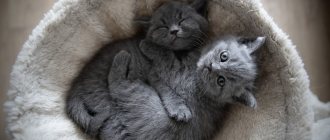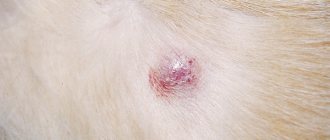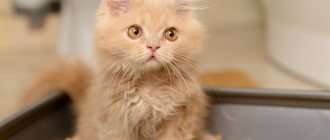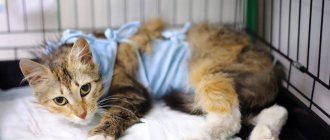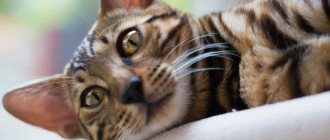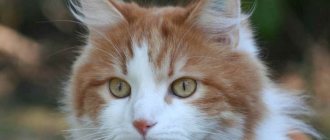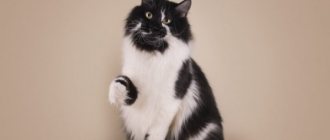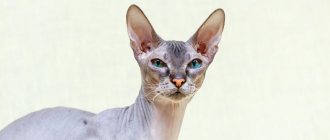- Pets
- >>
- Cat breeds
* Here is a photo of a typical representative of the Neva Masquerade cat breed . You can send us photos of your animals by email, and we will post them on the website. Don't forget to send your pet's name.
Video
* We invite you to watch a video about the Neva Masquerade cat . In fact, in front of you is a playlist in which you can select and watch any of 20 videos about a given cat breed by simply clicking on the button in the upper right corner of the window. In addition, the material contains quite a lot of photos. By looking at them you can find out what the Neva Masquerade cat looks like.
In this article:
|
Rate the material!
[Total votes: 1 Average: 5]
The Neva Masquerade cat is an aristocrat of the cat world. These mannered, graceful animals were bred in Russia and acquired unique character traits. For all their aristocracy, they remain harsh hunters and dangerous predators, capable of standing up for themselves. At the same time, they combine such character traits with the tenderness and attentiveness that goes to the owners of the cat.
Description and breed standard
The Neva Masquerade cat has a breed description similar to the Siberian. We can say that the Neva cat is a special case of the Siberian breed, with a certain color.
However, the masquerade cat is a separate breed and has its own standards:
- Athletic build with strong bones and well-developed muscles.
- The head is large and heavy, trapezoidal in shape with a low forehead and without sharp visible transitions in profile.
- Short strong neck.
- The eyes are large and round, slightly slanted.
- The ears are medium in size, set wide apart, tilted forward, and have rounded tips. Tassel decorations are welcome.
- The body is of medium length, strong, with a wide chest. The body fits into a rectangle.
- The paws are large and long, with tufts of hair between the toes.
- The tail of this breed is wide and fluffy, with a rounded tip. Its length is approximately up to the shoulder blades.
- The Neva Masquerade has a semi-long, fluffy coat. The coat lengthens from the withers to the tail. The neck is decorated with a collar, and the hind legs are decorated with pants.
An adult cat weighs 8-9 kg, females are smaller and lighter. The life expectancy of the Neva Masquerade is on average 13-15 years. In some cases, with proper care, they can keep company for up to 20 years.
The Neva Masquerade is one of the few breeds that can be called hypoallergenic. The breed is unique in its minimal content of allergy-causing antigens. Contrary to the general belief about wool allergies, the human body does not tolerate wool, but the antigen found in saliva. When an animal licks itself, saliva containing the allergen remains on the fur.
History of the origin of Neva masquerade cats
The Neva Masquerade cat appeared relatively recently - at the beginning of the twentieth century. This breed was gaining popularity in Europe, America and Russia. Cats of this breed began to be bred on a large scale in 1986, and were officially recognized only in 1988. However, not all associations still recognize this breed as official.
The history of the Neva masquerade cat is well known. It descended from Siberian cats, which were an indigenous breed found only in Siberia. These cats became the progenitors of many modern breeds of semi-longhaired and longhaired cats. Siberian cats lived in Russia for centuries, but became known only from the time of Peter I.
The origin of the Neva masquerade cat from a geographical point of view is difficult to establish. Their breeding was first started in the city of St. Petersburg, in the then popular club “Kotofey”. The breeder was Olga Mironova, famous at that time, who had a hand in many cats.
Interesting fact: The cats were named Neva cats in honor of the Neva River, where these animals originated. The masquerade cat was named due to its unusual color: a spot on its face that resembles a dark mask.
Subsequently, the cat was bred in Moscow. Moscow nurseries carried out selection separately from St. Petersburg ones, which contributed to some division of the breed, but at the same time added diversity to the genetic potential.
In addition to the Siberian cat, Siamese cats have also “invested” in the Neva Masquerade cat breed. In many ways, they influenced the color of the Neva Masquerade: dark muzzle, paws and tail. It is reliably known that Neva Masquerade cats are an exclusively Russian breed.
History of the breed
There are many versions about the origin of this breed. According to one of them, Neva masquerade cats are considered an aboriginal breed, which the world saw thanks to the crossing of Siberian cats and Siamese cats. The breed is considered quite young.
For the first time, these animals were put on public display at a Russian exhibition, which was held in St. Petersburg in 1988. It was there that they attracted the attention of visitors with their beautiful and unusual colors.
At the very first cat show held in the Soviet Union, out of a hundred participants, only three were purebred. All other animals are just barn cats.
Despite all these nuances, the exhibition was a great success and attracted a huge number of spectators.
The name of the breed consists of two parts. Due to the presence of a mask on the animal’s face, these cats are called “masquerade”. The second part of the name was decided to simultaneously immortalize the river on which St. Petersburg stands.
The Neva Masquerade cat differs from its Siberian relatives in its color-point color. Very unusual blue eyes are also memorable.
Today, these cats are popular not only in the Russian Federation, but also far beyond its borders.
Neva Masquerade cat - description of the breed
Neva masquerade cats have many differences from their closest relatives: Siberian and Siamese cats, although they inherited a lot from them. This is a fairly large breed. The weight of cats is approximately six kilograms, and the weight of cats is up to nine kilograms. They are proportionate and strong. The body is of medium length, not too stretched. The torso is massive, the neck is short and thick. Volume breasts and strong muscles.
The head is proportional, but massive, wedge-shaped and with smooth, rounded features. The forehead is round, low; wide nose of medium length, without humps. If you look at the cat in profile, there is a noticeable deepening in the transition from the forehead to the nose, but the transition is smooth. The cheekbones are set low, there is a fleshy cheek area, and the jaws are well developed. The chin is also smooth, but powerful and not protruded.
The ears of the Neva Masquerade cat are of medium size, very wide at the base and slightly tilted forward. The tips of the ears are softly rounded. The distance from ear to ear is small. The eyes are round and slightly slanted in setting. Eye color is necessarily blue, but can vary in shade. Up to a year, a green tint to the eyes is acceptable.
The legs of the Neva Masquerade cat are of medium length, very strong and muscular. Their paws are large - they inherited this from Siberian cats. The paws are round in shape, and soft hair grows in tufts between the toes. The tail of these cats is of medium length, well furred, widening towards the end and rounded at the tip. Owners note that this tail resembles a fox's.
Appearance, standards
The most attractive features of Neva Masquerade cats are their sky-colored, expressive eyes. They are round in shape, set slightly at an angle, the color of the iris can be of different saturation - from light to bright sapphire or ultramarine. Another distinctive feature of these beauties is their long, luxurious fur coat.
Externally, these cats are strong, proportional, and have a strong build. Medium to large in size, male cats are significantly larger in height and weight than female cats. The weight of a female can reach 5-6 kg; an adult cat sometimes weighs about 9.
The neck is not long, powerful, the chest is well developed. The limbs are proportional, giving the impression of a rectangular shape of the animal, the paws are round in shape. Representatives of this breed have tufts of hair between their toes; they inherited this feature from their Siberian ancestors.
Proportional trapezoidal head, developed cheeks, straight, medium-length nose, strong but not protruding chin. The ears are not long, set quite widely on the head. They taper slightly at the top, have round tips, sometimes with tassels, and are slightly inclined forward.
The tail is wide and long, fluffy, ending in a round tip. The coat is long, dense, with a double undercoat. The fur is smooth, shiny, with good texture. On the shoulder blades they are shorter, beautifully descending on the sides, forming a “collar”, mane and frill, as well as “pants”.
Popular colors of Neva Masquerade cats
The coat of Neva Masquerade cats is medium length and fluffy. They got it from a Siberian cat: it shines brightly and has the ability to repel water. Thanks to this, Neva masquerade cats hardly freeze, but they also do not like to swim. The coat lengthens, moving from the shoulder blades to the pelvic part, and smoothly falls to the sides and to the base of the tail. The fur around the neck forms a thick mane. Soft trousers are clearly visible on the hind legs.
This type of fur is called decorative fur: it is intended for aesthetic purposes, and not for keeping the cat warm. During the molting period, the panties from the hind legs and the shirtfront from the chest almost disappear. The cat's undercoat is long and thick, especially growing in winter, becoming denser. In summer, the cat sheds, and the undercoat becomes thin and light.
The guard hair and undercoat of the Neva Masquerade cat are light in color, and the tips of the ears, paws, tail and fur on the face are dark.
Depending on the darkness of the color, all colors of Neva masquerade cats can be divided into the following:
- Seal point and seal tabby point with classic chocolate and dark chocolate spots;
- Blue point with gray spots;
- Red point with red spots;
- Tortoiseshell point, which is found only in cats and not in cats.
Relatively recently, breeders have developed several colors that have silvery shades. Only the chocolate-lilac color scheme is excluded from the breed, and all other shades of masks are acceptable. The only condition: the contrast between the light coat and dark tones must be clearly visible so that the border is drawn.
Character and habits of Neva masquerade cats
Neva masquerade cats have graceful habits. They have a pronounced sense of self-esteem, which does not allow them to behave with these cats like children. With all their appearance and behavior they demonstrate nobility.
Only close people, owners and their children can freely play with this cat. With others, the animal behaves distantly and imposingly, does not show increased interest in new people, and also does not always allow itself to be stroked and, especially, to be picked up.
Neva Masquerade cats are sedate and proud animals with a balanced character. They are attached to family and to home comfort and silence. They like it when they are given attention, but do not ask for it intrusively. They sense the territory well and will not allow new animals into it: there is a high probability that they will respond aggressively to other cats and dogs.
Interesting fact: Owners of Neva Masquerade cats note that the animals love to listen carefully to their owners, are ready to provide emotional support and happily sit on the laps of their loved ones, purring quietly.
Despite their external appearance, Neva masquerade cats are very playful and love to move. Therefore, they get along well with children who are ready to constantly play with their pet. These cats are also characterized by curiosity about everything that concerns their owners: they are nearby when people are doing household chores.
Neva masquerade cats can hardly be called sissies or timid animals. From their ancestors - Siamese and Siberian cats, they received a harsh character and high adaptability to new conditions. You don’t have to worry about these cats if you let them go for walks near a private house. They can fend for themselves and have sufficient intelligence, although supervision of walks is still necessary. Neva masquerade cats themselves do not show aggression unless provoked.
Being good hunters, they can bring mice, birds and even moles into the house. You definitely shouldn't leave them near pet hamsters or parrots.
Interesting facts about Neva masquerade cats
The temperature at which kittens develop in their mother's womb has a curious effect on them. Small kittens are born completely white, rarely with a beige tint. Only later do dark spots appear on them, which distinguish the Neva masquerade cat from other breeds.
The color of representatives of the Neva Masquerade cats is a consequence not only of crossing Siberian cats with the Siamese breed. Neva masquerade cats have a special gene with thermal sensitivity. This gene prevents the pigment from penetrating the hair structure at high temperatures. Therefore, only the coldest areas, those exposed to the lowest temperatures, have a dark color: the muzzle, paws, tail and tips of the ears.
By nature, Neva masquerade cats are born aristocrats. Thanks to their habits, these cats are well brought up and will never go against their owners. For example, they almost never tear up furniture and are easily litter trained. Innate cleanliness greatly facilitates their maintenance - these manners are inherent in Neva masquerade cats at the genetic level.
Neva masquerade cats have a keen sensitivity to emotions. They always determine what mood the owner is in. And if they understand that people close to them are feeling bad, they are ready to lighten the mood with affectionate purring or flirting. They even relieve irritability or fatigue with their purring.
Cats of this breed are strong and dangerous predators. They should not be angered, since a cat can cause serious damage even to a person. Of course, the animal will not touch children or loved ones, but it is wary of strangers. Therefore, there is no need to insist on contact with the Neva masquerade cat if she does not want it herself.
Tips for choosing a kitten
Neva masquerade kittens will be a real asset. But in order to be sure of the purity of the breed, the kitten must be taken from a nursery or at an exhibition.
At birth, babies are light in color, so it is quite difficult to determine whether they belong to the Neva Masquerade cat breed.
This is precisely why the help of a specialist from a nursery will be so needed. A person with extensive experience will help you and answer all your questions. The nursery will provide documents confirming the breed of your pet.
Now almost every self-respecting establishment of this type has its own website. You can choose a kitten without leaving home by looking only at a photo.
But be sure to go pick up the baby yourself. After all, only in person can you understand whether the kitten is healthy, whether it is playful and active enough. The appearance of animals is of no small importance. Pets' fur should not be dirty or matted, and discharge from the eyes and ears is unacceptable. The baby should not have an unpleasant odor.
With personal contact, you will understand whether this is your baby or whether it is worth paying attention to other kittens.
Chocolate and lilac colors are considered a defect of this breed.
Kittens of this breed quickly get used to their new home. But it is important to remember that the baby was recently separated from his mother and brothers, with whom he was very friendly, and you need to give the pet the maximum amount of attention at first. Care and love will help the baby get over separation faster.
Do not purchase a kitten younger than 12 weeks of age. Very young kittens of this breed do not tolerate being separated from their mother.
Pros and cons of Neva Masquerade cats
The undoubted advantage of such a cat is its bright, attractive appearance and expressive eyes. She always attracts the attention of others and looks very impressive.
In addition to appearance, the Neva Masquerade cat has the following advantages:
- These are calm, sedate animals that will not cause chaos in the house;
- They are gentle and meek, very courteous with close people; patient, so they can endure playing with children for a long time, even if they don’t like it;
- They are not capricious at all, so they do not refuse food and can live in a wide variety of conditions. Therefore, there are no special requirements for maintenance - cats easily adapt even to life in a private home and to walking on the street;
- Neva masquerade cats have strong immunity and good health; cats of this breed are excellent hunters. By keeping them on private property, you can be sure that there will be no small rodents left on it;
- These cats have another interesting feature - they know how to choose a healthy mating partner who will provide the best offspring. An adult cat will never associate with a sick or aggressive cat.
The disadvantages of the Neva masquerade cat include:
- Large sizes, due to which these cats require space - at least seven meters for comfortable housing;
- Sometimes they are indifferent to their owners and require privacy. They don’t like strangers, and contacts with them can be viewed with hostility;
- They need to be combed out as often as possible;
- These cats should not be kept with other animals. They will eat smaller pets, and will treat larger ones with aggression and rejection;
- It is very difficult to find a cat with a proven and good pedigree for mating.
Mr. Cat recommends: Neva Masquerade and allergies
It is believed that representatives of the breed are ideal for allergy sufferers, as they have a special coat. However, this is not quite true. The Neva Masquerade cat can also trigger allergies, especially in people with high sensitivity to the allergen.
The fact is that an allergy is a reaction not directly to animal fur, but to protein compounds present in biological fluids and skin particles. The Neva masquerade cat produces significantly less of these proteins, but they are still present, so they can provoke an allergic reaction. They are indeed considered hypoallergenic, but the possibility of developing an immunological reaction to cat protein cannot be completely ruled out.
The Neva Masquerade cat, having appeared not so long ago, has already firmly won the sympathy of the whole world. The breed is extremely popular.
These cats are superbly handsome, a source of pride for the owner, and, in addition, reliable and loyal friends.
Breeding Neva Masquerade cats
The first heat of the Neva masquerade cat begins already in the ninth month of life. This is not at all a reason to breed a cat - her body is not ready for pregnancy and childbirth. On the contrary, early pregnancy is fraught with serious complications or even death. During heat, a cat becomes active, rolls around on the floor, screams a lot and demands attention. The cat is ready for mating only after the third heat, when the body has finally formed and the reproductive system is ready for pregnancy.
Neva masquerade cats mature later. You can determine that this happened by the cat’s behavior: it marks its territory, screams and tries to escape into the street. Sometimes a cat can become aggressive and start biting and scratching. The instinct of self-preservation almost disappears, so you need to be careful when handling such a cat.
Neva Masquerade cat for cats can be found from professional breeders. He must have all the documents and vaccinations that will make the mating safe and the offspring healthy. It is also possible to breed a cat with outbred cats, but it is undesirable to waste the genetic potential of the animal.
Pregnancy lasts approximately 65 days. The cat noticeably gains weight, and sometimes may vomit on an empty stomach. After half the pregnancy period, the cat's nipples swell and the belly grows very large. On day 49 you can already palpate the kittens.
In late pregnancy, the belly becomes pear-shaped and the cat moves as little as possible. She may also lose her appetite completely, but she will drink large quantities of water. Childbirth takes place under the supervision of a veterinarian, although Neva masquerade cats rarely experience difficulties with it.
Breed varieties
Cream and brown points
Seal point or seal tabby point kittens are very popular. They are considered one of the most beautiful, and this is an indisputable fact. So, the shade on their body is usually:
- beige;
- light;
- soft gray;
- light brown.
INTERESTING TO KNOW: Types of colors of Persian cats
Beige and light gray are especially common. Since a characteristic feature of the Neva Masquerade cat is color contrast, the rule remains unchanged for all representatives of this beautiful breed that the darker ones will be:
- ears,
- paws;
- tail;
- mask.
The contrast is especially clear on cats with a white body color and almost black limbs, ears and mask. Even on their body they have spots of a darker shade.
When talking about the color of a point's face, it is not without reason that the term “mask” is used. Photographs of these animals convince us that the unique color of the Neva masquerade cat creates the impression that the points actually have a mask on their face.
An invariable characteristic of the breed - contrast - is manifested even in kittens that have a dark coat color. Despite this, you can easily see that the ears, paws and muzzle are even darker in color. The richer the color of the cat, the darker its face will be.
Blue points
The next type of breed is the Blue Point cat. Blues differ from the previous species in that their spots on the body are lighter in color. It usually has a silvery-blue tint. This cat received a second name - blue.
Blue point and blue tabby point, as they are also called, must have a light-colored body so that the contrast is more noticeable. Blue Points look very beautiful due to their blue tint of fur and blue eyes. And the photos with them turn out simply excellent.
Red and reddish points
Another equally beautiful variety of points is red point and red tabby point. The color of Neva Masquerade cats of this species is considered rare. Compared to the blue, the red has a red coat color. When you admire their beauty, it seems that the body shimmers with light gold.
When kittens are certified, that is, kittens at the age of 2 months are determined to comply with the standard, difficulties arise in distinguishing red points from red tabby points.
In adult cats, a sign such as striping or its absence may become permanently established when the first kittens are born. In addition, a variety of cream point has appeared. These are kittens with a lighter shade of red.
Tortoiseshell color
The Neva Masquerade cat of tortoiseshell color is especially popular among breeders and cat lovers. It is called torty point or torby point. Such love for this variety is explained by the fact that from it it is possible to obtain offspring with a wide variety of tones, which is impossible in others.
Tortoiseshell coloring is achieved when there are cream or reddish shades in the base color. Sometimes these colors are produced with a tabby pattern. The coloring of these cats is truly unique. Each kitten that appears will be a unique tortoiseshell shade.
Siberian colorpoints
Another variety of the Siberian cat breed is the Siberian color-point bicolor. A distinctive feature of such cats is the presence of white spots on their paws and face. They do not have any high requirements regarding:
- their location;
- forms;
- symmetry.
INTERESTING TO KNOW: The smartest breed of Savannah cats
This is what makes cats different from each other. Each of them has an amazing magic of beauty: white “socks” on their paws and spots on their faces make the appearance of these cute animals especially attractive.
Silver color
Among the cats of the Neva Masquerade breed, this type of color is:
- seal silver point;
- red silver point;
- blue silver point.
True, cats with a reddish tint are much less common than others. These three varieties of the breed have a characteristic that distinguishes them from other colors - a light silver tint. It is created due to the fact that only the wool at the ends is dyed.
The special appeal of the silver color is that the presence of a white undercoat makes the silver color stand out, with the undercoat usually having finer hairs. Due to this combination of colors, it seems that the cat has some kind of glow from within. It looks very impressive.
Usually, both blue, red, and tabby acquire a more saturated color over time. But this does not in any way affect their beauty. They always attract the attention of exhibition visitors and judges.
Caring for Neva masquerade cats
The Neva Masquerade cat does not require specialized care. It usually needs to be brushed two to three times a week using a range of items. The owner of a fluffy cat should have a slicker brush in his arsenal, which effectively removes dead fur.
You also need to get a brush made of natural stiff bristles, a rubber glove and a comb with fine teeth. You will also need shampoo if your pet gets very dirty, which is rare.
If you do not properly care for the coat of the Neva Masquerade cat, then cleaning the house will be required several times a week. The thick fur of these cats often falls out, which creates severe discomfort when keeping it in an apartment. Also, the fur has a tendency to roll into tangles, which causes inconvenience to the cat itself.
It is not advisable to comb the tail of the Neva Masquerade cat. It is very sensitive, and even the slightest hair pulling can be an unpleasant process for the cat. The hair on the tail rarely falls out and is poorly restored, so when combing it is better to simply avoid it.
Important fact: To prevent your cat from tearing up the furniture in the house, it is better to purchase a scratching post. Typically, these well-mannered and intelligent animals easily get accustomed to such devices and do not touch the furniture.
You should regularly clean your cat's eyes with a cotton pad moistened with warm water, and also clean your cat's ears and teeth. Solid foods and special chewing toys work best for cleaning teeth. Neva masquerade cats love walks. If you live in a private house, then you can let your cat out on its own - a smart animal will not go far from its territory and will behave carefully. Special leashes are great for walking in the city. These cats can be walked even in winter because they are not afraid of the cold.
Features of maintenance and care
The long-haired beauty, of course, requires care, but it is not as difficult as it might seem. Regular brushing will help maintain the health and beauty of a luxurious thick fur coat. To do this, you need a brush with metal teeth. They shed twice a year, but if you constantly monitor your pet’s coat, it goes almost unnoticed.
The only thing you need to know: during the molting period, the decorative fur of these cats almost completely falls out, but soon a new one grows back - clean and silky.
Also, the cat should be washed regularly, using special products for cats with long and dense hair. The procedure should be performed infrequently, approximately once every three or four months. Unscheduled washing is necessary before exhibitions; you can bathe the animal before going to the veterinarian.
Mandatory care for a domestic cat includes cleaning the ears and eyes, trimming the claws. You should clean your ears about once a month as earwax accumulates.
If an excessive amount of it is formed, you need to show the animal to a veterinarian; this sign may indicate certain diseases.
The eyes should be cleaned daily, removing natural secretions with a cotton pad slightly moistened with water, towards the nose. Nails need to be trimmed as they grow. It is recommended to do this very carefully so as not to damage the cat’s fingers. Only the transparent part of the claw is trimmed. If you are not sure that everything will be done correctly, it is better to take your cat to a professional groomer. Nowadays, almost all veterinary clinics provide such services.
The cat also needs to regularly brush its teeth and mouth to avoid tartar and other diseases. To do this, you should purchase a special brush and paste for your pet (human pastes are not suitable for animals; they can damage the enamel). You should accustom your cat to brushing his teeth from a very early age, then he will tolerate it easily.
Cats of the Neva Masquerade breed are extremely clean and love to take care of themselves. It is quite easy to accustom them to the tray, but the training process should begin as early as possible. Some kittens are stubborn in this matter, but they can be dealt with with affection and patience.
When an animal gets used to the tray, it will never allow itself to do its business in the wrong place.
If your kitten doesn't want to go to the litter box, it may be that he doesn't like the litter. You should exchange it for another one and see how he reacts to it. In addition, it should be understood that cats themselves choose a place for the toilet, especially for wayward cats of the Neva Masquerade breed. Therefore, the tray should be placed where the animal has designated a place for itself to go to the toilet.
Nutrition
A properly organized diet is the key to a healthy pet. You can feed a cat of this breed both ready-made industrial food and natural food.
Human food is contraindicated for cats; they should not eat food with salt, spices, or various additives.
The finished food must be of high quality, suitable for the pet. Well-known brands offer food lines for cats of different ages, with different coat lengths, and also suitable for the individual characteristics of the pet. Choosing the right food is not difficult.
Experts recommend feeding dry food with some variety of canned food (several times a week).
It is recommended to accustom your pet to a certain style of feeding from childhood. Diet changes should only be made under extreme circumstances, as the animal's digestive tract adapts to digest certain foods.
If you decide to feed your pet natural food, you must follow certain rules. First of all, it is necessary to take into account that the cat belongs to carnivorous animals, therefore the structure and functioning of its gastrointestinal tract are designed to digest mainly soft fibers of meat and do not tolerate hard plant fibers well.
The diet of a predator should consist of meat, meat by-products and dairy products. You should choose dietary types of meat to feed your cat: veal, individual lean parts of beef (usually tenderloin), chicken, rabbit, turkey.
There is no need to give your animal fish, especially raw fish, since the presence of this product in the diet quite often leads to the development of urolithiasis, especially in castrated cats.
It is sometimes possible to pamper your pet if he loves fish, but this should not be done often. The product must be boiled, pitted and crushed under the small mouth of a cat.
The proportion of protein in the diet is at least 75-80%.
The protein component of the diet, in addition to meat and offal, should consist of eggs (give 2-3 times a week) and dairy products. Cats do not tolerate whole milk well in their gastrointestinal tract, but yogurt, fermented baked milk, and cottage cheese are suitable for feeding.
It is necessary to supplement the diet with a small amount of boiled vegetables, herbs, and cereals. With such a diet, it is imperative to take a course of vitamin and mineral supplements so that the pet’s body receives all the necessary substances.
Don't forget that your cat needs to consume enough fluid. There should be a container of clean and fresh water near the food bowl. It needs to be changed as often as possible, since the animal may refuse to drink the liquid that remains.
Health
From the ancestors of Siberians, who had to survive in rather unfavorable climatic conditions, Neva masquerade cats received good health and good immunity. Most representatives of this breed do not suffer from genetic abnormalities. These animals are recognized as long-lived among domestic cats; some individuals can live up to 20 years or more.
Like many other domestic cats, Neva Masquerade cats are susceptible to cardiomyopathy, a serious heart disease. Therefore, the pet must be regularly taken to the veterinarian for a medical examination.
To keep your cat healthy, the animal should also be vaccinated. The first vaccination against common viral infections is given at the age of two months.
If a kitten is taken from a nursery or from a breeder after this age, then you must ask for a certificate of vaccination. In the future, vaccinations are given according to schedule: not only against infectious diseases, but also against rabies.
Also, long-haired Neva masquerade cats should be regularly treated against ticks and fleas with special compounds or use an anti-flea collar. This is especially true if the pet walks on the street or goes to the country. In addition, it is necessary to give courses of anthelmintic drugs. By following all the rules and taking care of your cat’s health, you can keep her alive and vigorous for many years.
Diet of Neva masquerade cats
To keep your cat healthy and its coat beautiful, you need to achieve a complete, balanced diet. Neva masquerade cats are prone to obesity, therefore, when choosing natural food, you need to pay a lot of attention to portioning and balance in food. It is best to feed your cat 120 grams twice a day for an adult pet.
Most of the Neva Masquerade cat's diet is meat. You need to choose lean meat rich in protein: chicken, turkey, beef. The easiest way is to place meat with cereals, such as oatmeal, rice, buckwheat. Legumes that cats do not eat in the wild should not be given.
An important element of the diet is vegetables. Cats especially love fresh cucumbers, which contain a lot of liquid and important vitamins. Greens are also an integral part of the diet. In the summer, it is better to let your cat eat grass on the run, and in the winter, pet stores offer pots of home-grown greens, which cats enjoy eating. Cats can also be given raw chicken yolk once every three to four days.
Interesting fact: In addition to meat, Neva masquerade cats love to eat offal. These include the lungs, liver, spleen, kidneys, hearts, tracheas, etc. They can be frozen well in the freezer and thawed to room temperature, or they can be boiled a little and cooled. Hot or cold food should not be given to your pet, so as not to damage the enamel of the teeth.
Fermented milk products are rich in calcium. Fatty components are excluded from the cat's diet, but low-fat cottage cheese, kefir and yogurt without any additives can and should be given. Once every three days it is worth treating Neva masquerade cats with these products. You can also give them a few drops of high-quality vegetable oil to remove hair from the body.
Health of Neva cats
Neva cats are not the subject of artificial selection, which has a positive effect on their genetic predisposition to many diseases. Cats have fairly good health.
Diseases of Neva cats
A big problem for Neva carnival cats is the fur that gets into the gastrointestinal tract. Wool forms lumps in the stomach and causes eating disorders.
Important! To save the animal from such problems and make it easier to get rid of fur, you need to give a kitten a teaspoon of vegetable oil (sunflower), and an adult cat - a tablespoon.
In addition, cat owners are faced with heart failure in their cats. The main symptom of this disease is poor endurance and shortness of breath in the animal. To avoid missing this disease, you need to visit the veterinarian once every six months.
How long do Neva cats live?
The life expectancy of carnival cats with health control can reach 20 years. Average life expectancy is 15-17 years.
Diseases and health problems
Neva masquerade cats originated through natural crossing of cats of other breeds. Siberian and Siamese cats, their closest relatives, also enjoy good health. Neva masquerade cats have excellent immunity, and they also have no congenital diseases. This is one of the healthiest cat breeds in the world.
Interesting fact: These cats can be let out for walks even in winter. Neva masquerade cats love to jump in the snow, especially when their owner is nearby. At the same time, there is no need to worry that the animal will catch a cold - the Siberian blood in these cats gives them excellent adaptability to cold weather.
It is worth keeping an eye on the amount of fur that enters the cat’s body when it licks itself. The fur can seriously clog the digestive tract or colon, causing illness or even death. Therefore, it is worth regularly giving her vegetable oil and special pastes that help remove hair from the body.
In large cats, a disease called hypertrophic cardiomyopathy sometimes occurs. This is a heart disease during which blood stagnates in the vessels of the heart, causing pulmonary edema. The disease is difficult to predict, so you should simply have your cat examined regularly by a veterinarian so that he can identify early signs of the disease. Otherwise the animal dies.
Since Neva masquerade cats love to walk, it is necessary to strictly observe prevention against parasites: both external and internal. Regularly give products that remove worms from the body, and also make sure that fleas do not appear in your pet’s luxurious fur.
Care
The Neva Masquerade breed is very clean. Does not require special or unusual care.
It should be combed several times a week using special combs and brushes. A comb with stiff bristles and a comb will not hurt.
Mandatory combing of the breed
Regular washing is carried out once every few months with special shampoos for long-haired breeds. A separate wash can be done before an exhibition or a trip to the veterinary clinic.
Cats of this breed shed twice a year. Due to the good structure of the coat, combing is easy. If you regularly monitor the fur, you won’t have to clean it up again. The fur falls out quite a lot. If you don't comb your cat, tangles will form, which cause not only discomfort, but also illness as a result of frequent licking. Wool can also remain on furniture and clothing.
It is better not to comb a cat’s tail, as it is quite sensitive; cats may not like active contact with the tail. And besides, almost no hair falls out of the tail.
The fur of these cats loves warmth. It doesn't darken when warm.
Be sure to clean your eyes with. moistened with warm water, a cotton pad and ears using cotton swabs moistened with a special cleaning solution.
Start brushing your kittens' teeth from childhood to avoid the formation of stones and other oral diseases. Buy a special paste for cats and a separate brush. Solid food and chewing toys also help with cleaning.
Cats love to walk both in summer and winter
These cats love to go for walks. You can safely release the cats on the property; they will not go far from the house. And in the city you can walk even on a leash and even in winter, because the breed is quite frost-resistant thanks to its Siberian roots.
